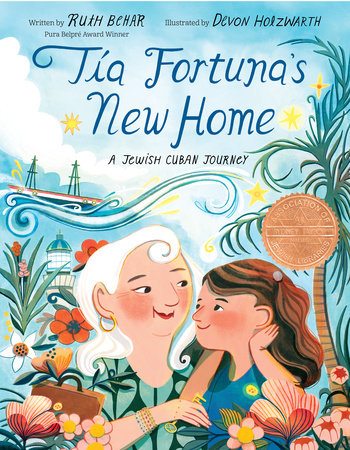Ruth Behar, Author, Devon Holzwarth, Illustrator
TIA FORTUNA'S NEW HOME: A JEWISH CUBAN JOURNEY
New York: Knopf Book for Young Readers, 2022, ISBN: 9780593172414
Reviewed by Rochelle Strauss1
When Estrella visits her Tia (aunt in Spanish) Fortuna at her pink, cozy Seaway home in Miami, she would be served warm borekas (turnovers) filled with potato or cheese. On this visit, Estrella and her mother are helping their elderly aunt move to an assisted living home. Her Seaway apartment will be torn down to make way for a hotel. Additional borekas have been baked to offer to the aunt's new neighbors. As she explains to Estrella, she baked them with the extra ingredient of hope. The borekas have been prepared by generations of ancestors, a tradition from Spain to Turkey to Cuba to the United States.
Although the text does not explicitly state that the family is Jewish, the illustrations make it clear, from the mezuzah on the doorpost and numerous pictures of religious objects. We do not know, however, why Tia Fortuna's ancestors made these journeys or why she left Cuba. Instead, we are to take to heart that tradition, memory, and family endure over generations and enable us to persist despite obstacles. Tia Fortuna reassures Estrella that childhood memories, such as hers of Cuba, will be a comfort to her. Their shared experiences at Seaway will not be forgotten. Tia Fortuna is resilient; the hope that enables her to accept change is an attribute that she encourages in Estrella. As a token, she gives the key to her Seaway home to her young great-niece. The key is both a souvenir of a beloved home and in anticipation of the key to the next dwelling, to create new memories.
The author's notes at the end of the book give context to the factual parts of the story. Ruth Behar, an award-winning author, briefly explains the events that forced Jews out of Spain, in the fifteenth century, and out of Cuba, in the twentieth century. She shares personal family information, including that she has a real Sephardic aunt in Miami. Also, the Seaway was a real apartment building in Miami. Jewish Cubans may be a less familiar group of Sephardim. Behar and Holzwarth add details that will be relatable to other Sephardic groups; such as specific words in other languages or the good luck bracelets worn by Tia Fortuna. The name “Fortuna” is common among Sephardic families.
Estrella narrates the story of this close family relationship. Her observations describe her aunt and the process of moving. Their conversations are very realistic and reveal their personalities. Estrella is a curious, loving child and her aunt responds with warmth, love, and patience. The reader can identify with a childlike Estrella, and, hopefully, have an adult like Tia Fortuna in their lives.
The story and the illustrations specifically depict moments in Tia Fortuna's move: spending a last day at the beach, packing possessions, then arriving at her new home. She is shown saying goodbye to the palm trees at Seaway and later, greeting the banyan tree in her new environment. These pictures are naturalistic. On some pages, when her memories are depicted, the pictures are more fanciful, with images floating across the page. The illustrator, Devon Holzwarth, used gauche, watercolor, colored pencils, and digital enhancement to create these vivid, colorful drawings. She has drawn the characters with soft features, exuding a warmth and appeal to the reader.
This unpaginated picture book is for ages five and up. The English text is interspersed with Spanish and other languages, explained in a glossary at the end. That might be a little off-putting for young readers, going back and forth for translations. A child who is read to, can be told the translation simultaneously. However, the words will become familiar when readers will want to reread the story and they will delight in discovering new details in the vivid illustrations. The book is also available in Spanish.
1 Rochelle Strauss is a retired librarian, Brooklyn Public Library.

